 |
[June 23rd 2003]
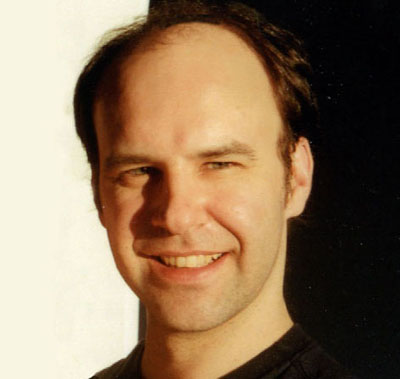
6 questions about digital art
Interview with Andreas Broegger
Andreas Broegger is
a significant source of knowledge on digital art forms in general,
and net art in particular. Thomas Petersen has asked Andreas
six questions about digital art, which has resulted in an extended
journey through part of the topics and problems related to the digital
art forms of the present. The interview is stuffed with links to
new and old works and can be used as a platform for doing some serious
net art surfing. The interview was translated by Sofie Paisley.
On a daily basis Andreas is a PhD. and teaches classes
on digital art at the Department of Comparative Literature at the
University of Copenhagen. He is visual arts editor of Hvedekorn
and contributor and former co-editor of afsnitp.dk (among other
things he was curator on the net art project ON OFF 2000-2001).
Since 1995, he has been an art critic for Information, Weekendavisen
and Politken, and has published articles in amons others: Kritik,
Øjeblikket, Periskop, SIKSI, Flash Art, rhizome.org, noemalab.com.
You can catch up with Andreas at this email address: broegger@hum.ku.dk.
See also Andreas
Broegger's introduction to software art.
See
also Andreas Broegger's interview with Mark Napier: 'The Aesthetics
of Programming'.
See
also Andreas Broegger's excellent survey text: 'Net art, web art,
online art, net.art'.
We could begin by establishing a focal point in the multitudes
of net art strategies - can you mention a recent work which has
had special meaning for you, and which sets out an interesting course
for net art?
As a 'focal point' we could take a work, which kopenhagen.dk's readers
might have experienced, namely Victor Vina's work Flux
exhibited at Electrohype in Malmoe in October 2002. This work combines
several different features which I find characteristic of net based
art at the present, in relation to the earlier net art all the way
back from 1994 and most of the end of the decade.
 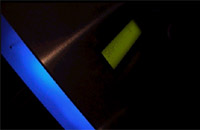
Victor Vina: Flux from Electrohype 2002. The images
were found at www.dosislas.org/flux and www.electrohype.org.
Described briefly, the project attempts to visualise and make palpable
the network's information flow in the shape of small, perfectly
done metal boxes with green displays, on which an eye can be kept
on what people around the world are searching for at the moment.
Search words and data are collected from a well-known search engine.
Vina discretely stated which search engine, but he does not want
this information made public, as it is illegal to hack into it,
so why not respect that. By touching the metal boxes you can then
further the searches appearing on the individual displays. Flux
contains traits characteristic of a lot of net art in recent years.
Flux looks rather good, data is encapsulated in sort of
miniature-minimalist metal boxes, there is an excellent idea behind
it, i.e. checking the pulse of our use of the internet by tapping
into a search engine, this takes place through a physical interface
designed by the artist, and finally there is a typical pointing
to something secret and border breaking (the illegal) as part of
the role of net art.
On the negative side, I see it as symptomatic that Flux
does not want to do very much with the data gathered and displayed.
It is a bit like WAP-ing from your mobile phone combined with monitoring
other people's searches on MetaSpy.
As far as the visual expression is concerned, Flux can be
compared to Listening
Post by Mark Hansen and Ben Rubin who, however, make more
of their data by incorporating the exhibition space. Contents wise,
I will place it within the context of works such as Common
Reference Point by Mark Daggett and Jonah Brucker-Cohen,
which (according to plans) similarly to Flux gathers and
visualises the net's flow of data, but simultaneously also deals
with the content plane of these data, first and foremost in a symbolic
connection (as a changeable virtual memorial of the 9/11 acts of
terror) but also as an analytical tool offering something else and
more than Flux's rather abstract picture of a flow.
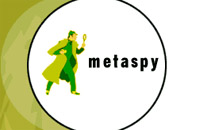 
Images from www.metaspy.com and Mark Daggett
and Jonah Brucker-Cohen's Common Reference Point.
It is thus possible to create links to texts regarding 9/11 found
by the project's search engine, and Common Reference Point
can tell us something about for example searches and locality, geographical
concentration, and the like. For comparison, Flux is not
particularly functional as "search engine". Even though
simplicity is a virtue especially in relation to the WWW, I feel
that there could have been one more level of reflection in Flux.
You might think that this is symptomatic of a lot of net art in
comparison to other visual art, but I do think that net art or any
art utilising telecommunication technology has and will have a lot
to offer in the present and in the years to come.
You write about the many genres of net art that have emerged.
I would like us to touch upon a couple of chosen 'types' of net
art and the different possibilities inherent in these.
Instead of talking about different types of net art it might be
better to talk about different 'dimensions' in the individual net
art projects - such as tactical media, data visualisation, design,
telerobotics, physical net interfaces, etc., as the majority of
works have by now become a mix of several of these things, as opposed
to being pure entities. The projects I mention here are all examples
of this. Some mourn that net art is already 'over', mainly because
the net looks a bit different today, is regulated and used in other
ways and because the art institutions and others empowered to give
grants, are beginning to influence this form of art in a particular
direction. In one way this is true when you compare it with the
early phase within net art. I am, however, not sure that going beyond
this phase is purely bad - it is also a new situation, a new challenge.
In general, I think that one of the most important things currently
happening to net art is that its borders are substantially widening.
Net art's early eagerness towards defining itself (being e.g. strictly
net specific) is giving way to a looser defined practice which can
include elements of a physical installation, and where the whole
concept of the net is expanded as e.g. visually based mobile telephony
becomes more widespread, and wireless internet connections in the
public space becomes a reality. I think this will change the perception
of what making art 'on the net' means - i.e. a convergence of WWW,
GSM, BPS, SMS, AM/FM, TV, and what else you might think of.
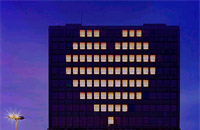 
Images from Chaos Computer Club: Blinkenlights
and 0100101110101101.org's VOPOS.
As an example see projects such as Chaos Computer Club's BlinkenLights
and Jonah Brucker-Cohen's various web and telephone projects such
as Audiobored
& Audiobored Machine, Phonetic
Faces and Musical/Devices.
0100101110101101.org's VOPOS
is also a clear sign of this reflection on 'convergence' in relation
to the earlier 'purism' with a clear focus on HTML- and pc-based
net art. And it does not have to be about the "disappearance
of the body" or a technologically extended body, as in an artist
such as Stelarc in the
1990s. I think art has moved a bit away from this area, which especially
grew out of the Virtual Reality discourse. Instead, for example
data visualisation, monitoring, access and alternative software
development has become the code words, in the same way as we also
see more works of a more traditional, purely aesthetic character
within net art, with stories not necessarily about the network,
the code, etc. As an example of this see David Clark's a
is for apple.

Images from David Clark's a is for apple
Quite a lot of net art has, more or less, the characteristics
of technology as its content. Is there any reason why net art should
be about networks, information flows and computer code?
Both yes and no. In the early phase of net art - the one often termed
'net.art.' with persons such as Alexei
Shulgin, Jodi, Vuk
Cosic, irational etc.-
focus was on exploring the new media as is typical when a new media
emerges (compare with e.g. photography and video art). The flickering
browser windows and blinking codes (Jodi),
the hacker mentality and the tactical use of media (Critical
Art Ensemble, rtmark, etoys,
Toywar etc.) and the pseudo-avant-garde experiments with for example
Alexei Shulgin's Form
Art meant that the net's processes and building blocks were
put at the forefront, at a time where exactly that kind of realities
were being covered by a sleek, commercial frosting.
Today when encountering code, information flows and the 'technocratic'
use of language on different sites (the tendency still exists in
different forms, see for example Florian
Cramer, mez,
jimpunk) a distinction should
be attempted made between a deconstruction in this original sense,
and a more 'poetic' use of code (see e.g. Graham Harwood's Lungs
and some of the works from Whitney's CODeDOC),
a focusing on the creative dimension of programming itself (as promoted
by John F. Simon Jr.) and
finally that which is merely show off with a technological style.
 
Images from jodi's wwwwwwwww.jodi.org and
Alexei Shulgin's Form Art.
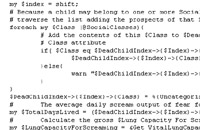 
Images from Graham Harwood's Lungs and
John F. Simon Jr.'s Every Icon.
Apart from a certain fetishist approach to codes visible in some
parts of net art (code for the sake of code), the reason for the
latter stylistic showing off is supposedly that the language and
apparatus of computer technology - in step with its development
through numerous generational changes - appears as historical. Computer
technology has therefore joined the general 1990s' retro- and nostalgia-trip
- the old ZXSpectums and C64s are brought out from their hiding-places.
This is why retro-technical expressions such as 'syntax-error' and
Atari logos emerge on T-shirts, as likewise pixellated symbols are
seen in printed materials and music videos. All because the computer
iconography appears as historical. This kind of meta-stylistic playfulness
does not really have much to do with the technical side of the code,
which is still reserved for the specially selected (most widely
spread within hacker mythology).
The Matrix films are typical of mainstream cultures fascination
with the equilibrists of the computer subculture, the glorification
and the turning into myth of the code aspect itself (cf. Link and
Neo's ability to read 'reality' directly in the stream of code.
In that universe the code equals truth - at the same time as the
film's many special effects are in themselves a deception created
with code).
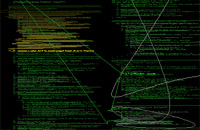 
Excerpts of work and code from W. Bradford Paley's
CODeDOC-project: CodeProfiles.
There are thus many different motives and strategies at play when
speaking of this interest in the code. This year Ars
Electronica is choosing 'Code' as their theme and very apropos,
connects computer code with genetic coding. An exhibition such as
Christiane Paul's CODeDOC
at Whitneys Artport was
an attempt at, in a concrete way, to put the program at the foreground
instead of the result of the program, and at finding the auteur-like
grips in the artist's way of programming.
In recent years, certain net artworks have received awards from
art institutions while the creators do not really see themselves
as artists. I am here thinking of for example some of the Ars Electronica
centre's granting of awards. Some of the creators even deny that
the awarded projects are art. Why do you think this occurs so often
precisely among the computer/internet based arts - and what does
in mean for the perception of the works?
Speaking about the granting of awards which have had a social
or political dimension, such as Ars Electronica's award for GNU/Linux
in 1999, they are an expression of a general tendency I think,
rather than something specifically characterising computer/internet
based art forms. With the contextual art, interventionist art and
the relational aesthetic, and what else it has been called, we have
seen a marked interest in art's social function, art's ability to
create alternatives, a better way of inhabiting the world, as Bourriaud
wrote.
If we, on the other hand, look at Ars Electronica giving Joshua
Davis' PRAYSTATION an award two years later, then we are dealing
with something quite different, that is, an interest in the creative
development within for example web design.
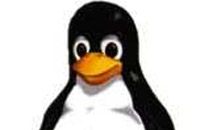 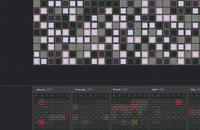
The Linux-penguin and an image from Joshua Davis'
Praystation.
The two examples sketch a quick picture of what is going on: i.e.
the widespread perception that the most advanced digital art might
not be created by those calling themselves artists, but by programmers
and product developers who in an open collaborative way create software
alternatives. In regards to what these granting of awards mean for
the reception of the digital art, I think that they are most interesting
and important from the viewpoint of art. I do not think that it
profits GNU/Linux noticeably that they have received a Golden Nica
award at Ars Electronica, neither ideologically, financially, nor
in relation to the productivity of the product. But within the digital
art (and art in general) that kind of decisions can contribute to
moving some borders.
Do you have any tips on current exhibitions, media art festivals
or other places where computer art or Internet art ca be experienced
outside the net?
As we do not have a distinct forum for it here, you have to travel
around quite a lot. Even though net art generally can be experienced
from a computer anywhere, it is interesting to see what environment
people work in, and its also not a disadvantage to have exchanged
a few words with the people behind it.
But apart from festivals, conferences and exhibitions I have gotten
a lot out of studying the subject from some other perspectives.
Last year I had the opportunity to follow the mounting of a large
exhibition, ABCDF,
at Museo de Bellas Artes in Mexico City, where I during several
weeks followed the people (some of them my friends and not least
my wife Isabel) who were down there to program and create interactive
installations for the exhibition. In spite of the fact that we are
talking about the leading interactive media company in Mexico, it
was a bit like being in the engine room of a ship - we were wading
around in cables, burned out chips, soldering irons, laptop computers
and pizza boxes, and worked from 8 in the morning until 2 in the
night.
 
Images from the exhibition ABCDF in Mexico
City and Tekken Torture Tournament at c-level in Los Angeles.
It was a far cry from the trendy offices in SoHo where a couple
of years earlier, several of the same people sat around with their
smoothies, getting massages, while cashing in $200 per hour on Flash.
Good for them though - the day after they were unemployed. In Los
Angeles, I several times visited a small artist-run place named
c-level, where exhibitions and
lectures are arranged, and where artists can also receive training
in constructing works with digital technology. This place existed
alongside conventions such as SIGGRAPH
and Electronic Entertainment
Expo at the same place. For me, this kind of contrasts are also
a part of the picture of digital art.
By now it seems that every country in Europe has a media art
festival - are there any signs of something on a larger scale happening
on that front in Denmark?
There have been initiatives of a certain size. 'Media art' not only
mixes with visual art but also literature, films and music, as demonstrated
by e.g. Lab, Datanom,
afsnitp.dk, the new interactive
documentary and feature films from Filmværkstedet, and a couple
of years back, Van Gogh's really good CD-ROMs not to be forgotten.
Electrohype in Malmoe is an example of the effort made to establish
something that could be a permanent forum.
Within net art, in connection with Denmark, we have amongst others
www.artnode.org, www.afsnitp.dk
and why not also mention www.kopenhagen.dk? By the way, these are
all admirable precisely because they keep going. It is decisive
that things are both created, and that a discussion can be continued.
But I am not sure that for example the festival form is the right
thing. It is insane to mount interactive installations and then
dismount them three days later. At the same time, I think that it
is problematic to ghettoise the digital art in separate festivals
or exhibitions. It is too important for that, it should reach a
broader audience, and I think that it would also at the same time
become better by being challenged by the 'non-digital' art. The
digital art is important because it often comes close to (and has
a deep insight into) the processes that increasingly control our
culture and society - from graphic effects to digital surveillance
and globalized communication. But, as for example Geert
Lovink has pointed out, the digital art is lacking behind in
other areas, both aesthetically, politically and culture analytically
speaking. Paradoxically at the same time as the digital technology
is culturally gaining influence.
The question of if we will get - or should have - a special forum
for media art, is connected to the problematics characteristic of
photography: should photo art be shown separately at exhibitions
and museums, or should it be mixed with the other visual art? It
is a difficult question. Something might be better understood within
a more narrow genre, tradition or media discourse, while something
else might do far better without this specific frame of understanding.
I would therefore rather answer your question with a new question:
In what frame would we prefer to see the digital art?
|
 |
|